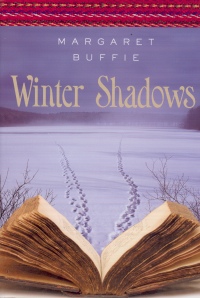| ________________
CM . . .
. Volume XVII Number 5. . . .October 1, 2010 
 |
Winter Shadows.
Margaret Buffie.
Toronto, ON: Tundra Books, 2010.
327 pp., hardcover, $21.99.
ISBN 978-0-88776-968-9.
Subject Heading:
Métis-Juvenile fiction.
Grades 7-10 / Ages 12-15.
Review by Joan Marshall.
**** /4
|
| |
|

excerpt:
I pulled on my housecoat and woolly socks and tiptoed down the stairs. The walls were bumpy and cold under my fingertips. I couldn't find the light switch. I understood why. My heart picked up speed as I neared the bottom.
Moonlight shone from two small windows across the main?floor foyer, sliding softly over dark green walls, a fur rug, and a hat rack made of deer antlers. The closer I got to the heavy oak doors of the main room, the stronger the music grew, becoming complex, sweet and melancholy. Then it stopped.
As I swung the doors open, I smelled wood smoke. A low black stove, with a big smokestack curling around the ceiling and out through one wall, glowed in the corner of the room. A dark haired girl sat beside a tiny piano, her candle wavering shadows around the walls. She was writing in a book on the table beside her. I watched her put down her pen, cover her face with her hands, and rock back and forth.
"Beatrice?" I called softly.
She became still. Then carefully, slowly, she turned to look at me.
Teenage Cass struggles to cope with her new stepmother Jean, and Jean's 12-year-old daughter, Daisy, who seem to be systematically erasing any presence of Cass' mother, Fiona, who died only 18 months ago. As their old pioneer house on the Red River is renovated, Cass finds a star shaped brooch, a catalyst that allows her to envision 18-year-old Beatrice Alexander, one of her Scottish/Metis ancestors. The ghostly Beatrice, living in Cass' house in 1856, is also dealing with a nasty stepmother, with the winter shadows of depression often enveloping her. In her diary, which she leaves out for Cass to read, Beatrice reveals her inner pain over her stepmother's viciousness and her confusion over which suitor she really wants to marry. When Cass' room is renovated, she finds the actual diary containing thanks to Cass from Beatrice for her support. Both Cass and Beatrice muster the control to meet their stepmothers halfway after discovering the suffering that these women have endured in their past marriages.
Cass' grief and anger threaten to overwhelm her; she often acts in a petty, vindictive manner, lashing out at her family, finding comfort and support only with her mother's twin sister and new friend/later boyfriend Martin. High school students in confrontational relationships with parents will empathize with Cass' problems. Like many adolescents whose parents die, Cass idealizes her mother, remaining mired in her own pain and unable to understand her father's needs and choices. Secondary characters in the present are well drawn, especially Aunt Blair and Martin, both of whom provide a steadying, calm influence on Cass.
It is Beatrice, though, whose character makes this novel sing. Her steadfast support of her father and his mother, Beatrice's native grandmother, demonstrates her moral strength. Her restraint in the face of stepmother Ivy's deliberate nastiness marks her as a woman, in stark contrast to Cass' self-centeredness. Readers will be delighted to watch Beatrice's gradual realization that she loves Duncan Kilgour and his warm, lighthearted courtship. Secondary characters in the past are exceptionally well presented. Beatrice's grandmother is a delightful, wise woman, while the cheerful Duncan and the stiff, formal Reverend Robert Dalhousie create laughter and tension as they each vie in their own way to earn Beatrice's love.
The past setting of this novel is simply stunning. Buffie immerses the reader in the cold, the food (and the effort it took to find and prepare it), the influence of the church, and above all, the intermingling of the Scottish and native and English cultures in the settlement near Selkirk, MB. She is clearly sympathetic to the native/Metis wisdom and connection with the land, using many Cree words (that are both easily understood in context and explained in a glossary).
The similarities between Cass and Beatrice's lives drive home the theme of the necessity of forgiveness and the crucial call for talk and communication in family life.
Buffie is a master of the ghost story, carefully allowing Cass and Beatrice to drift in and out of each other's lives in convincing fashion. The convention of the diary allows Cass to connect the dots and learn more about her ancestors. The dialogue both in past and present is authentic, revealing character and moving the action along.
Teens, especially girls, who love history or struggle with blended families, will be drawn to this well-crafted novel.
Highly Recommended.
Joan Marshall is a Winnipeg bookseller.

To comment
on this title or this review, send mail to cm@umanitoba.ca.
Copyright © the Manitoba Library Association. Reproduction for personal
use is permitted only if this copyright notice is maintained. Any
other reproduction is prohibited without permission.
NEXT REVIEW |
TABLE OF CONTENTS FOR THIS ISSUE
- October 1, 2010.
AUTHORS |
TITLES |
MEDIA REVIEWS |
PROFILES |
BACK ISSUES |
SEARCH |
CMARCHIVE |
HOME |
